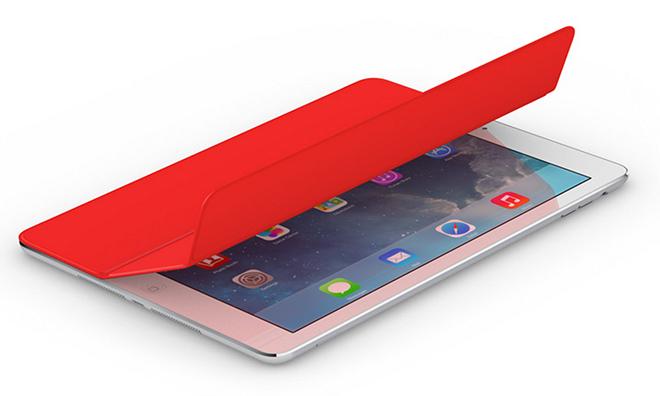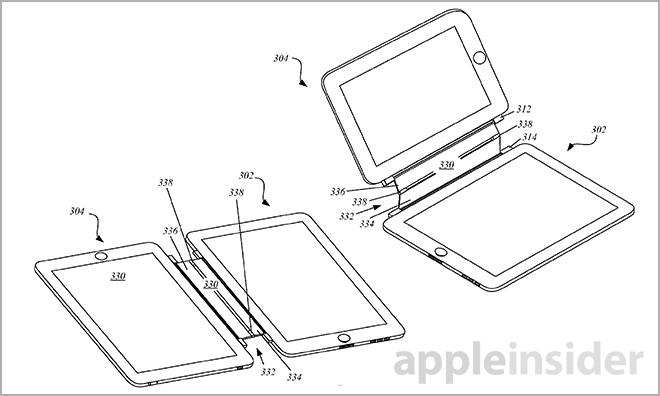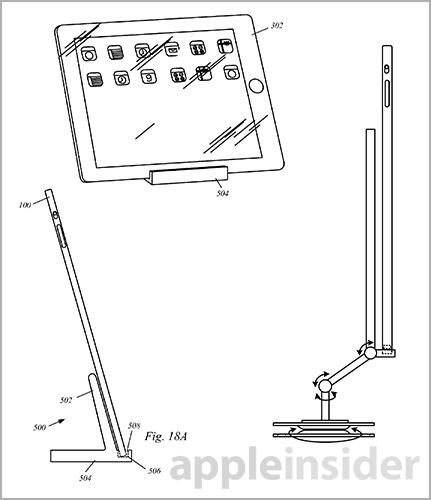An Apple patent application published by the U.S. Patent and Trademark Office on Thursday describes an intelligent magnetic attachment system that provides an interface for an iPad to connect and communicate with a variety of accessory devices, including other iPads.

Apple's patent for a "Magnetic attachment unit" has a basis in the keyed magnetic mechanism present in all iPads. Currently, Apple uses the internal magnet arrangement as a simple anchor point for Smart Covers or Smart Cases, but the proposed invention takes that idea much further.

Source: USPTO
Starting from the mechanics of the property, Apple proposes a keyed magnetic structure be embedded in an iPad's chassis, much like the existing implementation. By using keyed magnets, that is a specific arrangement of magnets, add-on accessories can be optimally positioned repeatably without much fuss. The document notes that these magnetic structures may be positioned on any side of the tablet body, including the bottom for use with docks and stands.
Traditional magnets can be deployed, as well as electromagnets that can be controlled via the device's operating system. For example, if a user wants to attach or detach an accessory, they can simply press the home button for hands-free operation.

Moving on to attachable accessories, Apple describes methods in which an iPad can be connected to a variety of cases, electronic devices and even other iPads. By leveraging the tablet's internal wireless hardware suite, any number of accessory devices may be operatively coupled to the iPad.
Apple offers a variety of solutions, from "static" cases and docks to "active" peripherals like game controllers and detachable keyboards.

In some embodiments, the system can include a magnetic attachment unit as illustrated above. This implementation would allow for the connection of two tablets to form a cooperating system. The orientation can be imagined as two tablets attached side-by-side via an intermediary magnetic unit, like an e-reader with two screens. In Apple's invention, however, each display would have the computing power of an iPad.
For example, if a user were to employ the magnetic attachment unit seen above, they would be able to take advantage of two devices in a single portable package. A range of use scenarios would be available, limited only by software. Screen tiling could provide an elongated continuous screen, or a student would be able to view class material on one screen while typing on another.
In a second embodiment, a detachable segmented cover is described. Identical in form to the current Smart Cover, this design can be deployed with an integrated keyboard, touch-sensitive drawing pad or other useful input options. Communication with the tablet would again be performed over wireless protocols.
Other accessories may be custom-built to augment the tablet's usability. For example, a stylus holder is described that, when magnetically attached, sends a signal to the iPad directing it to activate a special stylus recognition mode. Once the attachment is released, the tablet returns to normal operation.
As seen in the above illustrations, everything from cameras to credit card readers are accounted for in the document. One interesting example includes an external storage device that could theoretically be implemented into a Smart Case design.
The patent goes on to explain that a sensing circuit can be employed within the magnetic attachment mechanism to sense when an accessory or second device is operatively connected. A simple circuit can utilize a retaining magnet electrically isolated from the grounded device frame. When an accessory's magnet couples with the retaining magnet, current is allowed to flow to ground.
By distributing sensing circuits at multiple retaining magnets in the keyed magnet structure, the tablet is able to sense when specific accessory is attached. For example, the circuit may output different logic values for a stylus stylus holder than a detachable keyboard.
More common implementations would use the magnetic attachment system to connect accessories like Smart Covers. Here Apple offers a few other options, like the straps and hangers seen above. Also mentioned are docks that can hold and pivot an iPad on a rotatable arm. Other docking solutions include a stand for landscape orientation viewing and the usual electrical port charging system seen in today's products.
Finally, hidden within the patent language is an embodiment that calls for a user to wear a magnetic ring that can control an iPad's Hall Effect sensor. In current Apple hardware, the Hall Effect sensor is used to determine the presence of a Smart Cover, which in turn controls the power state of the tablet. If an iPad were enabled for the feature, a user wearing a magnetic ring would be able to "swipe" across the sensor to activate certain software functions.
Apple's magnetic attachment system patent application was first filed for in October, 2013 and credits Sean S. Corbin and Andrew D. Lauder as its inventors.